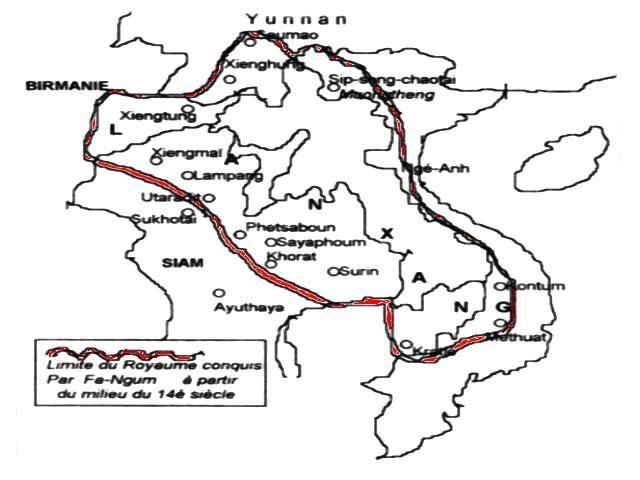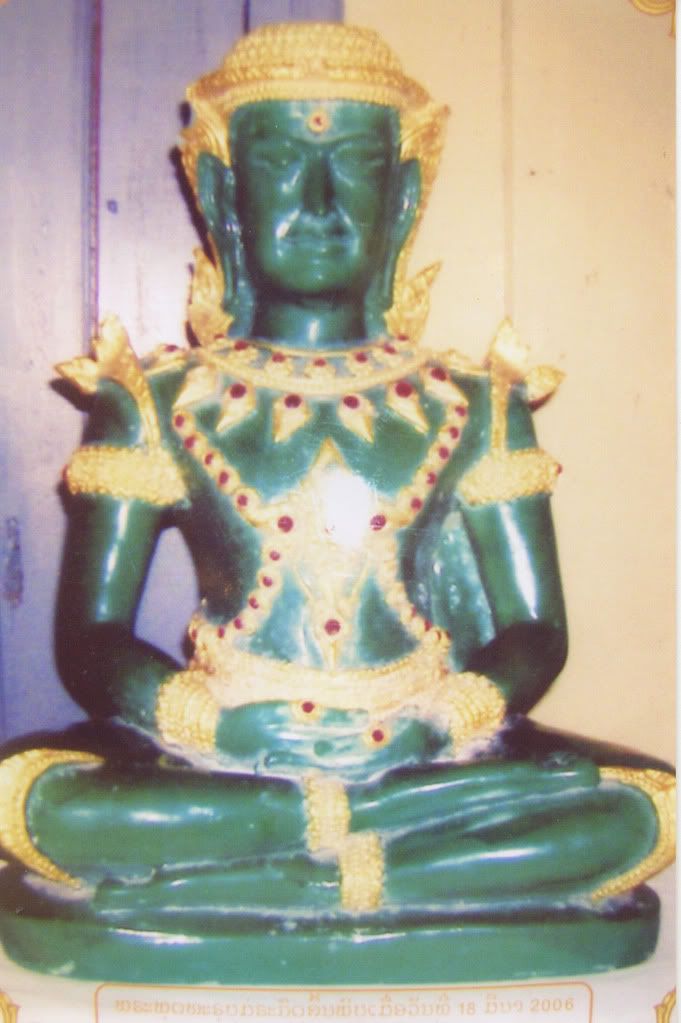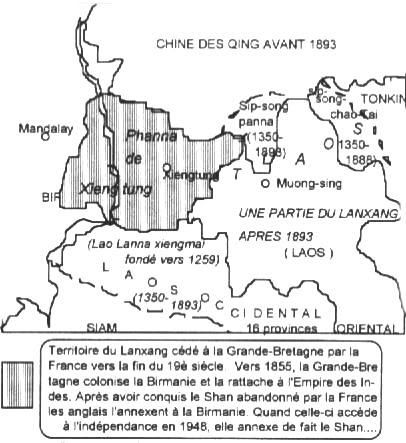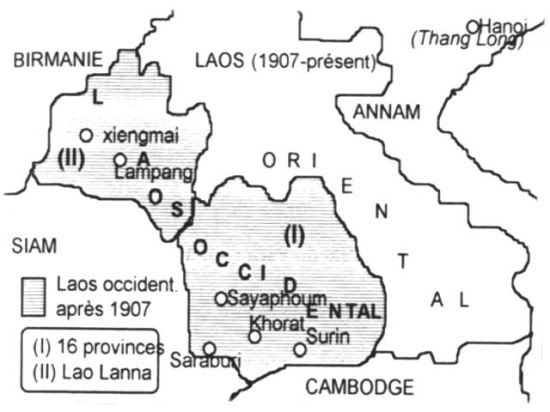
AiLao
-
Posts
16 -
Joined
-
Last visited
Content Type
Profiles
Forums
Downloads
Posts posted by AiLao
-
-
Isaan Maps
in Isaan
-
Well I would say Isaan tattoo are identical to the cousin across the Mekong river(Lanxang River), the tattoo are mostly cover the thighs and that is the reason why we're called Lao Poung kaow and Lanna was called Lao Poung Dum because of tattoo stomach.
-
Isaan Maps
in Isaan

-

The first time Siam invaded ViengChan was in 1779. Before the arrival of Siamese troops many scripts and statues had been remove from 126 temples in ViengChan to safe places. In 1828 the Siamese troops returned to VTE and burnt 125 temples and relocate over 300,000.000 Lao people to out skirt of Bangkok.
-
kingdom of Lao Lane-Xang (Muaong Xieng Dong Xieng Thong)
from 757 to 1707.
“Lane-Xang” is the old name of “Laos”, before 1893, the year when France colonized officially this Kingdom weakened by the invasions of the countries bordering. The territory of Lane-Xangenglobait all the provinces of the North-East and the North of current Thaïland, Laos, an Eastern part of Burma, Sip-Song-Banna in Yunnan Chinese, Sip-Song-Chau-taï in Western Tonkin, with the limit of the red river, a province of the North of Kampuchea, Konton, Methoua and Darlac.
Laos is one of the parts of the old Kingdom of Lane-Xang, detached free-Siamese, Franco-Chinese, Franco-English, free-Vietnameses signed towards the end of the 19è century and the beginning of the 20è century.
By these treaties, the Lao people had lost most of the territory of Lane-Xang to the profit of his more aggressive neighbors.
LUANG PRABANG CENTERS KINGDOM OF LANE-XANG.
F& Période missing of the end of the 8è century at the end of the 13è century.
$ Khun Lo (“Khun Lo” titrates of Prince at the time of Nan Chao…), wire of Khun Borom (Piluoge), first king of Lane-Xang whose capital is Xieng-Dong-Xieng-Thong (Quoted of forests and gold), is charged by his father with controlling at the same time this kingdom, and Nan Chao (Yunnan).
$ 780. Died of Khun Lo. His/her son, Khun Sung succeeds to him.
$ 780…? Reign of Khun Sung. After its death, there are 16 successive Princes on the throne as follows:
1. Khun DEK. 2. Khun Khoune. 3. Khun Khûn. 4. Khun Khab. 5. Khun Khao. 6. KhunKhane.
7. Khun Pheng. 8. Khun Pheune. 9. Khun Phi. 10. Khun Hung. 11. Khun Kham. 12. Thao Phane.
13. Thao Gnoung. 14. Thao Gneuk. 15. Thao Phin. 16. Thao Phat.
(“Thao” titrates honorary conferred to the national heroes, to the kings or to the prince as from the time of Lane-Xang).
From the reign of Thao Phat, Lane-Xang completely cuts the relation traditional with Nan Chao, Kingdom-mother, under the Mongolian domination. Nan Chao does not exist any more that of name and the dynasty of Nan Chao controlled by kings Aï Lao comes to a end into 902. From this year the population of Nan Chao is under the foreign dynasty (“end of the dynasty of Aï Lao de Nan Chao”). -
Here are some of the informations I like to share with those who is interested in our ethnic back ground. Most of this informations are gathered from the Chinese manuscripts and translated into French language.
Under the repression of another powerful kingdom in old China, Aï Lao under different identity, emigrated towards the South. Several groups managed to found each one their kingdom in a new territory. Of other under L (identity TaïLao or Lao, under the direction of Khun Borom (Piluoge), still king of Nan Chao, towards 730 apr. J-C., took their exodus according to Nam-Or (Laos), the red river and the black river in Tonkin with the conquest of new territories among the people Krom, Môn, Môn-Khmer.
Khun Borom sent its seven sons in the seven Lao principalities in the Indochinese Peninsula to take them in hand with knowing
$ Khun Lo, wire elder and heir to the throne of Nan Chao, control Lane Xang (Muong-Swa or Luang Prabang);
$ Chief-Chueng reign on Muong-Phouane (Xieng-Khouang, Northern Lao)
$ Khamphong, on Lanna (current area of the North of Thailand).
$ Chusong, on Ngé-Ang (Annam).
$ Kom, on Khamkeut (in the current province of Khammuane, Laos).
$ Kgua-Inh, on Lane-Phia (Ayuthaya), and
$ Yue-Phalane (Gniphalane), on Yunnan.Will add more and provide reference at the end if anyone is interested.
-
Here is couple of old Lao song by Tom Rainbow, some of you may have seen it and some may not... enjoy and tell me know what you think.
-
-
Isaan Maps
in Isaan

Hope I don't get ban for this!
-
Isaan Maps
in Isaan

What do you all think about this map of Lanna and Isan?
-
Here is what I've found from Mahidol University by Kritsana Athapanyawanit
" A Tonal Study of Lao Dialect in Kanchanaburi Province"
Lao dialect are spoken not only around the Thailand~Lao border and in the province of Northeastern Thailand (Isan) but also in various province in the Central region of Thailand. This study investigates a Central Lao dialect, namely, Kanchanaburi Lao dialect. The study locations are Rangwan village, Tambon Thasao, Amphoe Thamaka and U~long village, Tambon Thakhanun, Amphoe Thongphaphoom. The data were collected from six native Lao informants from sixty to ninety years of age.
Comparative Linguistics
Moderator: Elly van Gelderen, Department of English, Arizona State University
-
of course Udon Thani should be the capital, i believe it was the capital of the region when it was apart of a larger kingdom, way way back, before the capital was moved across the river to Vientiane.
it should have a Constitional Monarch.
Khorat is the Economic base since it is closet to BBK.
Kon Kean should be the cultural center,
Oh come on here, since when did the capital of Isan located accross the Mekong river (LanXang River). Vientiene has always been the capital of Isan since it was moved from Luang Prabang in 1560 by king Saysethathirath.
-
O yeah, "Thai" means free, i had forgotten
in central Thailand, if Thai means "free" then what does "Tai" mean?
maybe Isan should be Tailand? then they would have to annex southern Isaan to Kampuchi, since they are mostly ethnic Khmer.
The meaning of Tai apply to a person from the certain area of Land. As for example, people in Lao we still call each other Tai Viengchan, Tai Phuan, and Tai Luang Prabang. Tai is also known as AiLao (Lao) the word Tai came about during the migration of AiLao people from Southern China in two gruops, the first group is Tai Yai who migrated into the land of Souvanaphoum about 2,600 years ago, and the second was known as Tai Noi who created the AiLao kingdom 2,100 years ago.
-
Hi everyone, I'm new here and very excited about this forum. Hopefully we can exchange knowledge on our cultures. I know its little bit over 100 years since Isan and part of Lanna went under influence of Siam (AiLao/Mom~Khmer) but I'm sure you all still can be friends.
Please excuse my poor English skills, hope I can learn more by being here reading the post(s)
Thanks!

-
Who invented the art of Muay Thai, Thai (Siamese) Khmer or AiLao?
About 4,000 years ago, nomads called the Ai-Lao (as the Thais were called by the Chinese) settled in West-Central Asia, having fought their way up from the Indian continent. Their federation of Kingdoms grew and flourished until 200 B.C., when the Han-dynasty of China began their wars of expansion. Vastly outnumbered, the Ai- Lao managed to hold off wave after invading armies, thanks mainly to their great skill with weapons, but eventually, the greater numbers of the Chinese won out and the Ai-Lao became vassals to the Szechuan-empire. Rather than live under Chinese rule many of the Ai-Lao gradually migrated south into the forests and jungles of Southeast Asia. The wandering Ai-Lao-people divided into three branches; The Shans who settled in Burma, The Ahom who went East into Vietnam and the Lao-Tai who wandered into Laos. By the 7th Century A.D, the Ai-Lao tribes still in China had become the so-called independent Kingdom of Nanchao. And for the next 100 years, Nanchao and China were constantly at war usually as enemies, but occasionally as allies against the Tibetan tribes to the west. (One Tibetan tribe in particular, the Burmans later became Thailand's worst enemy). By the end of the 9th century, Nanchao had been absorbed into the Chinese empire but at the same time, the first Thai states were forming into today's Laos and Siam, the name of ancient Thailand.
The Ai-Lao became a powerful force, ready to expand and conquer. By the year 1350, northern Siam and Most of Laos was united into Kingdom of Lan Xang and prince Uthong of Ayudhhya began a new dynasty, which was to last for 400 years. This was the Golden Age of Thailand, but with its prosperity came constant warfare against the Burmese to the west and the Khmers to the South East. To ensure the survial of their country, the great warriors of the nation were brought together and distilled the vast combat- knowledge of their people into a training-method called the Chupasart. Because the methods of combat-training were recorded and kept up to date, the martial art of Thailand never fragmented into different styles and systems. There were improvements and innovations added to the text, but every change was first proven on the battlefield or in the ring.
You believe this craps?





Isaan Maps
in Isaan
Posted
During the visit of Thailand. Dinner at the Grand Palace. Offered by His Majesty the King of Thailand and in the honours of their Majesties the King and Queen of Laos on July 20, 1955.